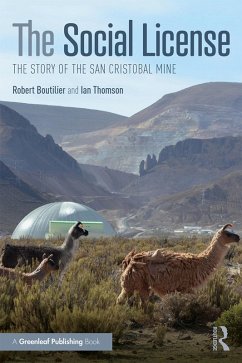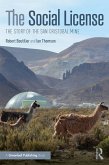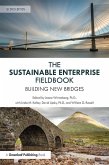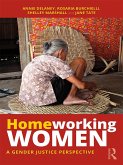40,95 €
40,95 €
inkl. MwSt.
Sofort per Download lieferbar

20 °P sammeln
40,95 €
Als Download kaufen

40,95 €
inkl. MwSt.
Sofort per Download lieferbar

20 °P sammeln
Jetzt verschenken
Alle Infos zum eBook verschenken
40,95 €
inkl. MwSt.
Sofort per Download lieferbar
Alle Infos zum eBook verschenken

20 °P sammeln
- Format: ePub
- Merkliste
- Auf die Merkliste
- Bewerten Bewerten
- Teilen
- Produkt teilen
- Produkterinnerung
- Produkterinnerung

Bitte loggen Sie sich zunächst in Ihr Kundenkonto ein oder registrieren Sie sich bei
bücher.de, um das eBook-Abo tolino select nutzen zu können.
Hier können Sie sich einloggen
Hier können Sie sich einloggen
Sie sind bereits eingeloggt. Klicken Sie auf 2. tolino select Abo, um fortzufahren.

Bitte loggen Sie sich zunächst in Ihr Kundenkonto ein oder registrieren Sie sich bei bücher.de, um das eBook-Abo tolino select nutzen zu können.
This book traces the development of new concepts and measures in the field of stakeholder engagement while following the narrative of a community struggling with a fundamental change in its identity from a declining, malnourished llama herding village to one of the richest towns in Bolivia.
- Geräte: eReader
- mit Kopierschutz
- eBook Hilfe
- Größe: 2.01MB
Andere Kunden interessierten sich auch für
![The Social License (eBook, PDF) The Social License (eBook, PDF)]() Robert BoutilierThe Social License (eBook, PDF)40,95 €
Robert BoutilierThe Social License (eBook, PDF)40,95 €![Managing Community Resettlement (eBook, ePUB) Managing Community Resettlement (eBook, ePUB)]() Robert GerritsManaging Community Resettlement (eBook, ePUB)49,95 €
Robert GerritsManaging Community Resettlement (eBook, ePUB)49,95 €![Sustainable Energy Branding (eBook, ePUB) Sustainable Energy Branding (eBook, ePUB)]() Fridrik LarsenSustainable Energy Branding (eBook, ePUB)37,95 €
Fridrik LarsenSustainable Energy Branding (eBook, ePUB)37,95 €![The Sustainable Enterprise Fieldbook (eBook, ePUB) The Sustainable Enterprise Fieldbook (eBook, ePUB)]() The Sustainable Enterprise Fieldbook (eBook, ePUB)39,95 €
The Sustainable Enterprise Fieldbook (eBook, ePUB)39,95 €![Business Ethics (eBook, ePUB) Business Ethics (eBook, ePUB)]() Christian U. BeckerBusiness Ethics (eBook, ePUB)39,95 €
Christian U. BeckerBusiness Ethics (eBook, ePUB)39,95 €![Homeworking Women (eBook, ePUB) Homeworking Women (eBook, ePUB)]() Annie DelaneyHomeworking Women (eBook, ePUB)45,95 €
Annie DelaneyHomeworking Women (eBook, ePUB)45,95 €![Solarnomics (eBook, ePUB) Solarnomics (eBook, ePUB)]() David WrightSolarnomics (eBook, ePUB)38,95 €
David WrightSolarnomics (eBook, ePUB)38,95 €-
-
-
This book traces the development of new concepts and measures in the field of stakeholder engagement while following the narrative of a community struggling with a fundamental change in its identity from a declining, malnourished llama herding village to one of the richest towns in Bolivia.
Dieser Download kann aus rechtlichen Gründen nur mit Rechnungsadresse in A, B, BG, CY, CZ, D, DK, EW, E, FIN, F, GR, HR, H, IRL, I, LT, L, LR, M, NL, PL, P, R, S, SLO, SK ausgeliefert werden.
Produktdetails
- Produktdetails
- Verlag: Taylor & Francis eBooks
- Seitenzahl: 204
- Erscheinungstermin: 10. Oktober 2018
- Englisch
- ISBN-13: 9780429018596
- Artikelnr.: 54117204
- Verlag: Taylor & Francis eBooks
- Seitenzahl: 204
- Erscheinungstermin: 10. Oktober 2018
- Englisch
- ISBN-13: 9780429018596
- Artikelnr.: 54117204
- Herstellerkennzeichnung Die Herstellerinformationen sind derzeit nicht verfügbar.
Robert G. Boutilier is a strategy consultant, social researcher, and Associate of the Centre for Sustainable Development at Simon Fraser University, Canada.
Ian Thomson is a practising social consultant, researcher and communicator with more than 40 years of experience in the natural resource industries, most recently as principal of Shinglespit Consultants Inc., Canada.
Ian Thomson is a practising social consultant, researcher and communicator with more than 40 years of experience in the natural resource industries, most recently as principal of Shinglespit Consultants Inc., Canada.
Preface
Part One: Historic Context
Chapter 1: In the Beginning
Chapter 2: The Historical Roots of Divergent Views of Fairness
Chapter 3: Bolivian Politics from the Spanish to the Neo-Liberals
Chapter 4: The Anti-Foreigner Turn
Part Two: Retrospective from Discovery to Operating Mine
Chapter 5: Social License Concept
Chapter 6: From Geological Discovery to Construction 1994-2004
Chapter 7: Construction: 2004 to 2006
Chapter 8: Transition to Operating Mine: 2007 to 2009
Chapter 9: Renegotiation of Roles and Rights: 2010 and 2011
Part Three: Stakeholder Strategies from Quantitative Measures
Chapter 10: Shift to Quantitative Risk Assessment Methods
Chapter 11: Co-evolution of Risk Hotspots with Bolivian Politics and
Economy: 2009 to 2015
Chapter 12: From Findings to Strategies that Work
Part Four: Distinctive Features and Conclusions
Chapter 13: Women and the San Cristóbal Mine
Chapter 14: The Trouble with Llamas
Chapter 15: Concluding Observations
Part One: Historic Context
Chapter 1: In the Beginning
Chapter 2: The Historical Roots of Divergent Views of Fairness
Chapter 3: Bolivian Politics from the Spanish to the Neo-Liberals
Chapter 4: The Anti-Foreigner Turn
Part Two: Retrospective from Discovery to Operating Mine
Chapter 5: Social License Concept
Chapter 6: From Geological Discovery to Construction 1994-2004
Chapter 7: Construction: 2004 to 2006
Chapter 8: Transition to Operating Mine: 2007 to 2009
Chapter 9: Renegotiation of Roles and Rights: 2010 and 2011
Part Three: Stakeholder Strategies from Quantitative Measures
Chapter 10: Shift to Quantitative Risk Assessment Methods
Chapter 11: Co-evolution of Risk Hotspots with Bolivian Politics and
Economy: 2009 to 2015
Chapter 12: From Findings to Strategies that Work
Part Four: Distinctive Features and Conclusions
Chapter 13: Women and the San Cristóbal Mine
Chapter 14: The Trouble with Llamas
Chapter 15: Concluding Observations
Preface
Part One: Historic Context
Chapter 1: In the Beginning
Chapter 2: The Historical Roots of Divergent Views of Fairness
Chapter 3: Bolivian Politics from the Spanish to the Neo-Liberals
Chapter 4: The Anti-Foreigner Turn
Part Two: Retrospective from Discovery to Operating Mine
Chapter 5: Social License Concept
Chapter 6: From Geological Discovery to Construction 1994-2004
Chapter 7: Construction: 2004 to 2006
Chapter 8: Transition to Operating Mine: 2007 to 2009
Chapter 9: Renegotiation of Roles and Rights: 2010 and 2011
Part Three: Stakeholder Strategies from Quantitative Measures
Chapter 10: Shift to Quantitative Risk Assessment Methods
Chapter 11: Co-evolution of Risk Hotspots with Bolivian Politics and Economy: 2009 to 2015
Chapter 12: From Findings to Strategies that Work
Part Four: Distinctive Features and Conclusions
Chapter 13: Women and the San Cristóbal Mine
Chapter 14: The Trouble with Llamas
Chapter 15: Concluding Observations
Part One: Historic Context
Chapter 1: In the Beginning
Chapter 2: The Historical Roots of Divergent Views of Fairness
Chapter 3: Bolivian Politics from the Spanish to the Neo-Liberals
Chapter 4: The Anti-Foreigner Turn
Part Two: Retrospective from Discovery to Operating Mine
Chapter 5: Social License Concept
Chapter 6: From Geological Discovery to Construction 1994-2004
Chapter 7: Construction: 2004 to 2006
Chapter 8: Transition to Operating Mine: 2007 to 2009
Chapter 9: Renegotiation of Roles and Rights: 2010 and 2011
Part Three: Stakeholder Strategies from Quantitative Measures
Chapter 10: Shift to Quantitative Risk Assessment Methods
Chapter 11: Co-evolution of Risk Hotspots with Bolivian Politics and Economy: 2009 to 2015
Chapter 12: From Findings to Strategies that Work
Part Four: Distinctive Features and Conclusions
Chapter 13: Women and the San Cristóbal Mine
Chapter 14: The Trouble with Llamas
Chapter 15: Concluding Observations
Preface
Part One: Historic Context
Chapter 1: In the Beginning
Chapter 2: The Historical Roots of Divergent Views of Fairness
Chapter 3: Bolivian Politics from the Spanish to the Neo-Liberals
Chapter 4: The Anti-Foreigner Turn
Part Two: Retrospective from Discovery to Operating Mine
Chapter 5: Social License Concept
Chapter 6: From Geological Discovery to Construction 1994-2004
Chapter 7: Construction: 2004 to 2006
Chapter 8: Transition to Operating Mine: 2007 to 2009
Chapter 9: Renegotiation of Roles and Rights: 2010 and 2011
Part Three: Stakeholder Strategies from Quantitative Measures
Chapter 10: Shift to Quantitative Risk Assessment Methods
Chapter 11: Co-evolution of Risk Hotspots with Bolivian Politics and
Economy: 2009 to 2015
Chapter 12: From Findings to Strategies that Work
Part Four: Distinctive Features and Conclusions
Chapter 13: Women and the San Cristóbal Mine
Chapter 14: The Trouble with Llamas
Chapter 15: Concluding Observations
Part One: Historic Context
Chapter 1: In the Beginning
Chapter 2: The Historical Roots of Divergent Views of Fairness
Chapter 3: Bolivian Politics from the Spanish to the Neo-Liberals
Chapter 4: The Anti-Foreigner Turn
Part Two: Retrospective from Discovery to Operating Mine
Chapter 5: Social License Concept
Chapter 6: From Geological Discovery to Construction 1994-2004
Chapter 7: Construction: 2004 to 2006
Chapter 8: Transition to Operating Mine: 2007 to 2009
Chapter 9: Renegotiation of Roles and Rights: 2010 and 2011
Part Three: Stakeholder Strategies from Quantitative Measures
Chapter 10: Shift to Quantitative Risk Assessment Methods
Chapter 11: Co-evolution of Risk Hotspots with Bolivian Politics and
Economy: 2009 to 2015
Chapter 12: From Findings to Strategies that Work
Part Four: Distinctive Features and Conclusions
Chapter 13: Women and the San Cristóbal Mine
Chapter 14: The Trouble with Llamas
Chapter 15: Concluding Observations
Preface
Part One: Historic Context
Chapter 1: In the Beginning
Chapter 2: The Historical Roots of Divergent Views of Fairness
Chapter 3: Bolivian Politics from the Spanish to the Neo-Liberals
Chapter 4: The Anti-Foreigner Turn
Part Two: Retrospective from Discovery to Operating Mine
Chapter 5: Social License Concept
Chapter 6: From Geological Discovery to Construction 1994-2004
Chapter 7: Construction: 2004 to 2006
Chapter 8: Transition to Operating Mine: 2007 to 2009
Chapter 9: Renegotiation of Roles and Rights: 2010 and 2011
Part Three: Stakeholder Strategies from Quantitative Measures
Chapter 10: Shift to Quantitative Risk Assessment Methods
Chapter 11: Co-evolution of Risk Hotspots with Bolivian Politics and Economy: 2009 to 2015
Chapter 12: From Findings to Strategies that Work
Part Four: Distinctive Features and Conclusions
Chapter 13: Women and the San Cristóbal Mine
Chapter 14: The Trouble with Llamas
Chapter 15: Concluding Observations
Part One: Historic Context
Chapter 1: In the Beginning
Chapter 2: The Historical Roots of Divergent Views of Fairness
Chapter 3: Bolivian Politics from the Spanish to the Neo-Liberals
Chapter 4: The Anti-Foreigner Turn
Part Two: Retrospective from Discovery to Operating Mine
Chapter 5: Social License Concept
Chapter 6: From Geological Discovery to Construction 1994-2004
Chapter 7: Construction: 2004 to 2006
Chapter 8: Transition to Operating Mine: 2007 to 2009
Chapter 9: Renegotiation of Roles and Rights: 2010 and 2011
Part Three: Stakeholder Strategies from Quantitative Measures
Chapter 10: Shift to Quantitative Risk Assessment Methods
Chapter 11: Co-evolution of Risk Hotspots with Bolivian Politics and Economy: 2009 to 2015
Chapter 12: From Findings to Strategies that Work
Part Four: Distinctive Features and Conclusions
Chapter 13: Women and the San Cristóbal Mine
Chapter 14: The Trouble with Llamas
Chapter 15: Concluding Observations







